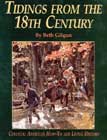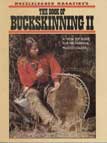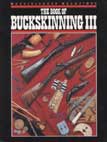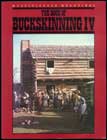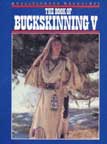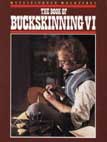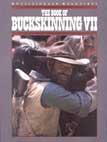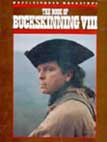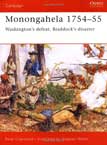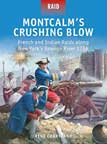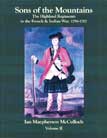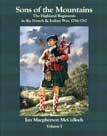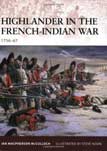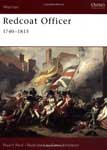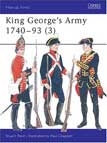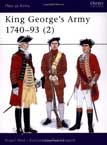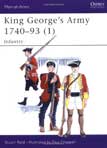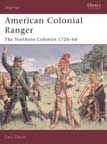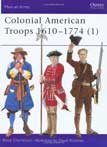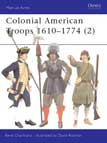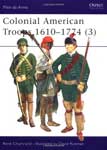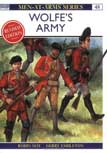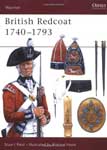

Beth Gilgun brings the mid to late 1700s to life with her entertaining and informative "letters" to a friend on the frontier. Great for reenactors, teachers, historic interpreters, and theatrical costumers. As an accomplished seamstress and goodwife, Gilgun shares with her "friend" information on clothing for men, women and children, as well as other topics of daily life in Colonial America. Included are clear, concise instructions for constructing reproduction 18th century garments, from choosing fabric to finishing. Her chatty letters include news about current events and the latest goods available on the East Coast.
*I met Beth Gilgun at a RevWar event once. I found her to be as neat in person as she seems in her books.
In-depth information on recreating life on the American frontier. Expand your enjoyment of living history with chapters including: Horseback Travel, Powder Horns, Canoeing, Camp Gear, Leather Clothing and Gun Tune-Up & Care. Each chapter was written by an experienced and knowledgeable participant in frontier reenacting. Lavishly illustrated with photographs and line drawings.
Explore recreating life on the American frontier. Solid information shared by knowledgeable and experienced reenactors help modern-day frontiersmen get started in the sport known as buckskinning. Subjects include: Historic Guns & Today's Makers, Quillworking, Trade Beads, 18th & 19th Century Cooking, The Hunting Pouch, Beadworking, Techniques for Making Footwear, and Period Shelters. Special color section of beadwork, quillwork, authentic frontier clothing, and trade bead photos
Enhance your frontier skills and knowledge. Each chapter was written by a knowledgeable and experienced participant in the sport known as buckskinning and lavishly illustrated with photos and drawings. Chapters include: Traditional Blacksmithing, Blankets in Early America, From Raw Hides to Rawhide, Styles of the Southwest, Smoothbores on the Frontier, Trade Silver, Backwoods Knives, Lighting the Primitive Camp, and Historic Sites & Museums. Emphasis is on demonstrating skills and how-to information.
Practical frontier American skills and knowledge are the focus in part five of this series on the sport known as buckskinning. Each chapter was written by a different author with in-depth knowledge of his or her topic. Chapters include: Fur Trade Indian Dresses; Old-Time Music & Instruments; Trade Goods for Rendezvous; Tipi Know-How; Engraving & Carving; Historic Sites & Museums II; Games, Sports & Other Amusements; and Pack Saddles & Panniers. Special color section features the dress of fur trade Indian women and horseback photos. Each chapter is abundantly illustrated with photos and drawings.
Hands-on frontier skills and in-depth historical information. Part six in this bestselling series on the pastime of recreating the American frontier, known as buckskinning, features more first-rate historical information and clear, hands-on instructions in the skills and crafts of the American pioneers. Chapters include: The Traditional Hunting Pouch, Horse Gear-East & West, Making a Wooden Bow, American Powder Horns, Frontier Trail Foods, Old-Time Shooting Matches, Period Trekking, and Finger Weaving. Special color section features photos of period horseback trips, powder horns, hunting pouches, and finger-woven sashes.
Best-selling guide to skills and crafts of frontier America. This book on the pastime of recreating the American frontier, known as buckskinning, continues the tradition of passing along accurate, practical information for the modern-day historian and reenactor. First-rate historical research and hands-on crafts include: Clothing of the Rocky Mountain Trapper, 1820-1840; Indian-Influenced Woodsmen of the Cane; Tools & Techniques of Bark Tanning; A Wardrobe for the Frontier Woman, 1780-1840; A Typical Day's Journey in Winter; Goods of the Trunk Maker & His Trade; Art & Writing on the Frontier; and Great Lakes & Eastern Woodlands Knife Sheaths. Includes a special color section featuring original art and artifacts plus reproductions. Each chapter was written by a knowledgeable participant in his field and is fully illustrated with photos and drawings.
Best-selling guide to skills and crafts of frontier America. Continuing the tradition with another in the bestselling series on the pastime of recreating the American frontier, known as buckskinning. Sound historical research and clear, understandable instructions in the crafts and skills of the American pioneers. Each chapter was written by an experienced participant and is lavishly illustrated. Chapters include: Gear of the Rocky Mountain Trapper, Beaver Hunting, Wing Shooting with a Flintlock Shotgun, History of the Horse in the Fur Trade, 18th Century Tatooing, The History & Trade Ledgers of Fort Hall, Independent Women of America's Past, Beadwork in the American West before 1850, and The Evolution of the Cocked Hat.
Osprey's examination of one of the key campaigns of the French and Indian War (1754-1763). On 9 July 1755 amid the wilderness of North America, Britain suffered one of the most humiliating defeats in her history. General Braddock’s army, a mixture of British regulars and American militia, was shattered, losing over 900 men from a force of 1,300. Braddock was killed and the remnants of his army rescued by his aide, Colonel George Washington. The origins of this defeat can be traced back to the death of a junior French officer little more than a year before in a relatively minor skirmish with a party of Virginian militia commanded by the same George Washington. René Chartrand examines the subsequent chain of events that ultimately sparked a world war.
With expert analysis and lively narrative, this engaging study of the Oswego raid casts light on a daring feat of arms at the height of the French and Indian War.
The year 1755 saw the rivalry between Britain and France in North America escalate along the Great Lakes into open warfare as both sides sought to overcome the other's forts and trading posts. Lord Loudoun and the Marquis de Montcalm were sent from the mother countries to take charge, but the French lost no time in seizing the initiative, adopting Canadian-style "wilderness" tactics and planning a series of raids to keep the enemy on their toes.
Amid the snows of March 1756, a 360-man French, Canadian, and Indian force stormed an Anglo-American outpost named Fort Bull in a surprise attack that left few survivors and the fort reduced to charred remains. Fort Bull's fall meant that the Mohawk River, the communication route between British-held Albany and the large and important Anglo-American post at Oswego, could now be cut off. Oswego, on the shore of Lake Ontario, had a formidable garrison based in three forts, named Pepperrell, George, and Ontario. The newly arrived Montcalm was tasked with the job of taking Oswego from the Anglo-Americans.
In July and August 1756, Montcalm's 3,000-strong force - including a full train of artillery, 80 pieces strong - was transported in hundreds of sailing ships and craft. The Anglo-Americans failed to spot the approaching French forces until they had landed and secured their positions. Having surrounded and invested the forts, the French soon knocked out of action a number of British guns. The British evacuated Fort Ontario and then, at 9am on August 14th, a French cannonball killed the British commander, Colonel James Mercer. His successor, Colonel John Littlehales, did not have the stuff of a hero; an hour later, the white flag went up and Oswego surrendered just in time to avert a major onslaught.
The Oswego raid was an outstanding French success; it denied the British a presence on Lake Ontario for the next two years, and relieved British pressure on Fort Frontenac. It demonstrated that the use of traditional European siege tactics in an American setting could reap great rewards, and had a great influence on the French's Indian allies too.
Detailed essays on 18th-century uniforms, Highland weapons, specialist officers, and men (including pipers), as well as a comprehensive biographical index of all regimental officers (over 350 entries), who served in the three regiments--the 42nd (Black Watch), 77th (Montgomery's) and 78th (Fraser's) Highlanders--make this book the most complete and informative work on the history of the early Highland regiments of the British Army in North America during the French and Indian War to date.
Chronicles the stirring story of the three Highland regiments that soldiered in North America during the French and Indian War. The exploits of the 42nd (Black Watch), 77th (Montgomery's) and 78th (Fraser's) Highlanders, in some of the most bloody and desperate battles ever fought on the this continent, were a critical factor in transforming the overall image of Highlanders in the latter half of the 18th century from Jacobite rebels to Imperial heros.
Colonial American historian Ian Macpherson McCulloch uses rare sources to bring to life the stirring story of the three Scottish Highland regiments that operated in North America during the French-Indian War (1754-1763). Forbidden to carry arms or wear the kilt unless they served the British King, many former Jacobite rebels joined the new Highland regiments raised in North America. Involved in some of the most bloody and desperate battles fought on the North American continent, Highlanders successfully transformed their image from enemies of the crown to Imperial heroes. The author pays particular attention to the part they played at Ticonderoga, Sillery, Bushy Run and on the Plains of Abraham, Quebec.
The commissioned officer ranks in the British Army from 1740-1815 were almost entirely composed of the affluent and educated - the sons of the landed gentry, the wealthy, and other professional people. This title looks at the enlistment, training, daily life and combat experiences of the typical British officer in the crucial periods of the North American conflicts, the American Revolution, and the Napoleonic Wars. It compliments the author's previous treatments in Warrior 19 British Redcoat 1740-93 and Warrior 20 British Redcoat (2) 1793-1815, which deal exclusively with the common infantryman, and balances these discussions through a look at the 'fellows in silk stockings'. Particular emphasis is placed on the experiences and activities in North America in the late 18th century.
The 18th century was marked by a steady growth in central control of the British Army and a corresponding decrease in the influence enjoyed by individual commanding officers. The most obvious sign of this process was the increasing uniformity of the clothing issued each year to the soldiers. Nevertheless, as far as those who devised the Clothing Regulations were concerned, it was a constant, and invariably quite uphill struggle to enforce compliance. This companion volume to Men-at-Arms 285 and Men-at-Arms 289 examines the organization and uniforms of King George’s cavalry and artillery together with those of the Board of Ordnance.
The 18th century was marked by a steady growth in central control of the British Army and a corresponding decrease in the influence enjoyed by individual commanding officers. The most obvious sign of this process was the increasing uniformity of the clothing issued each year to the soldiers. Nevertheless, as far as those who devised the Clothing Regulations were concerned, it was a constant, and invariably quite uphill struggle to enforce compliance. This companion volume to Men-at-Arms 285 takes a further look at the infantry uniforms of the mid-18th century British Army, also covering the various auxiliary infantry formations, such as the Militia, Volunteers, Marines and the troops of the East India Company.
To most contemporary politicians the 18th century British Army was no more than an unwelcome necessity in wartime and an unjustifiable extravagance in peacetime. Nevertheless, the overall impression which is to be gained from a close study of the Army's own records, and from the surviving letters, diaries and memoirs, is that the British Army of the 18th century was very little different in character or in spirit from today's British Army. It was, above all, a force which was led, not driven, into battle. This book looks at the uniforms and organisation of the infantry of King George's Army as well as its participation in various conflicts, such as the War of the Austrian Succession (1740-1748) and the Seven Years' War (1756-1763).
This title examines the development of the Colonial Rangers in this period, and shows how they were taught to survive in the woods, to fight hand-to-hand, to scalp a fallen foe, and to fight across all types of terrain and in all weather conditions. Based on previously unpublished source material, it paints a vivid picture of the life, appearance and experiences of an American colonial ranger in the northern colonies. Covering the battle at Lovewell's Pond in 1725, a watershed event in New England’s frontier history, through to King George's War (1740-1748), the rangers were prepared for the final imperial contest for control of North America, the French-Indian War (1754-1763).
From the earliest English settlements the survival of the infant colonies in North America depended upon local militias. Throughout the 17th and early 18th centuries the burden of successive wars with the American Indians, and with the regular troops and militias of Britain's colonial rivals France and Spain, fell mainly upon locally raised volunteers. This first of a fascinating three-part study includes a general introduction and chronology, and chapters on Crown troops in North America; and begins a colony-by-colony review of militias and provincial units. The text is illustrated with rare early images and with eight specially commissioned full colour plates.
From the earliest English settlements the survival of the infant colonies in North America depended upon local militias. Throughout the 17th and most of the 18th century royal troops were seldom shipped out from Britain, and the main burden of successive wars with the American Indians, and with the regular troops and militias of Britain's colonial rivals France and Spain, usually fell upon locally raised soldiers. These units also fought alongside the Crown forces during major operations such as the French-Indian War of the 1750s. This second of a fascinating three-part study covers the militias and provincial troops raised in Massachusetts, New Hampshire, Connecticut, Rhode Island, Maryland, New York and New Jersey.
From the earliest English settlements the survival of the infant colonies in North America depended upon local militias. Before the mid-18th century royal troops were seldom shipped out from Britain, and the main burden of successive wars with the American Indians, and with Britain's colonial rivals France and Spain, fell upon locally raised units, which also fought alongside the Crown forces during the major operations of the French-Indian War of the 1750s. This final book of a fascinating three-part study covers the militias and provincial troops raised in the Carolinas, Pennsylvania, Delaware, Georgia, Nova Scotia, Hudson's Bay and Quebec Province; and also Rangers, and colors and standards.
The British victory at Quebec in 1759 was a landmark in the history of North America. In this "year of miracles," according to Horace Walpole, one could "never afford to miss a single copy of a newspaper for fear of missing a British victory somewhere." Of all the pivotal figures in the Seven Years' War (1756-1763), a cast which included George Washington, Sir William Johnson, Lord Howe and Montcalm, Major-General Wolfe remains etched most deeply in Americans' memories for his heroic leadership at Quebec. Enhanced by illustrations and photographs, this book focuses on the British forces throughout their disastrous and triumphant wilderness campaigns which ultimately ensured the birth of the English-speaking United States of America.
During this period, the British army earned itself a formidable reputation as a fighting force. However, due to its role as a police force at home, and demonisation by American propaganda during the American Revolution (1763-1776), the army was viewed as little removed from a penal institution run by aristocratic dilettantes. This view, still held by many today, is challenged by Stuart Reid, who paints a picture of an increasingly professional force. This was an important time of change and improvement for the British Army, and British Redcoat 1740-1793 fully brings this out in its comprehensive examination of the lives, conditions and experiences of the late 18th-century infantryman
Marinus I begins his reign as Catholic Pope succeeding John VIII
King Henry VI of England crowned King of France
King Francois I orders renewed pursuit of Protestants
Mount Vesuvious, Italy erupts, destroys 6 villages and kills 4,000
Oliver Cromwell sworn in as English Lord Protector
General Monck demands free parliamentary election in Scotland
English Parliament adopts Bill of Rights after Glorious Revolution
Prussian Libya falls to Silezie
Russian army occupies Kolberg
Van Ritter von Glucks opera "Alceste" premiers
Big tea party in Boston harbor-indians welcome (Boston Tea Party)
Napoleon Bonaparte divorces Empress Josephine by French Senate
8.0 earthquake shakes New Madrid, Missouri
Leaders of Molukkas uprising hanged in Ambon
Great North Holland Canal opens
Fire consumes over 600 buildings in New York City
Boers beat Zulu chieftain Dingaan in South Africa
Earthquake in Naples, Italy
Dutch government decides to vacate Schokland Island
Kingdom of Nepal accepts its constitution
Battle of Nashville ends after 4400 casualities
Republic of South-Africa forms
Rift at Dutch Reformed Church over "Doleantie"
Negro Methodist Episcopal Church founded in Jackson, Tennessee
1st submarine with an internal combustion engine demonstrated
Boer army under General Kritzinger take Cape colony
Boer general Kritzinger captured
Majestic Theater, NYC, becomes 1st in US to employ women ushers
"Variety, " covering all phases of show business, 1st published
Eugene H Farrar is 1st to sing on radio (Brooklyn Navy Yard NY)
1st credit union in US forms (Manchester NH)
US pressure forces Nicaraguan President Jose Santos Zelaya from office
1st US postage stamp picturing an airplane, 20 cents parcel post, issued
Austria-Hungary engage in conflict with Serbia
Charlie Chaplin began his film career at Keystone for $150 a week
Albert Einstein publishes his "General Theory of Relativity"
Jack Dempsey KOs Carl Morris in 14 seconds
Mutual Association of Eastern Colored Baseball Clubs) formally organizes
Darius Milhauds opera "Le Pauvre Matelot, " premieres in Paris
Kenesaw Mountain Landis renewed 7-years as baseball commissioner
WOW-AM in Omaha NE begins radio transmissions
Chicago Blackhawks 1st game at Chicago Stadium, beat Pittsburgh Pirates, 3-1
Golfer Bobby Jones wins James E Sullivan Award
German SPD begins Eiserne Front against fascism
Heavy earthquake ravages Kansu China, 70,000 killed
Abe de Vries and Sipke Castelein win Elfstedentocht
Bradman scores 143 South Australia vs. NSW, 11 fours 91 singles
British air raid on Mannheim
Joe Louis KOs Al McCoy in 6 for heavyweight boxing title in Chicago
Sarawak occupied by Japanese
Hitler orders combat against partisans in Russia and Balkan
"Tamiami Champion" trains collide, kills 73 and injures 200
Battle of Bulge begins in Belgium
German V-2 strikes Antwerp bioscope (638 kill)
US 2nd Inf division occupies "Heartbreak Crossroads" Wahlerscheid
Cleveland Rams win NFL championship
"Lend an Ear" opens at National Theater NYC for 460 performances
Sukarno becomes President Indonesia, Mokammed Hatta Premier
Truman proclaims state of emergency against "Communist imperialism"
1st White House Press Conference: President Eisenhower and 161 reporters
Charles E Yeager flies over 2,575 km/h in Bell X-1A
"Fanny" closes at Majestic Theater NYC after 888 performances
Snow falling in Lowarai Pass West Pakistan kills 48
"Wildcat" opens at Alvin Theater NYC for 172 performances
TWA 266 and United 826 collide over Staten Island, kills 134
"Evening with Yves Montand" opens at John Golden NYC after 55 performances
Nepal gets constitution / becomes Constitutional Hindu Monarchy
New York Giant YA Title sets NFL season touchdown pass record at 33 with 6 touchdowns vs. Dallas (41-31)
Gemini 6 returns to Earth
Pioneer 6 launched into solar orbit
Beatles release "Everywhere its Christmas" in the UK
Jimi Hendrix Experience releases its 1st single, "Hey Joe, " in the UK
Wilt Chamberlain of NBA Philadelphia 76ers scores 68 points vs. Chicago
KFIZ TV channel 34 in Fond du Lac, WI begins broadcasting
"War is Over! If You Want It, Happy Christmas from John andYoko" posters begin appearing
British House of Commons votes 343-185 abolishing the death penalty
1st successful landing on Venus (USSR)
Bangladesh (East Pakistan) declares independence from Pakistan
Bangladesh Constitution goes into effect
Miami Dolphins become 1st undefeated NFL team (14-0-0)
O J Simpson becomes 1st NFLer to rush 2,000 yard in a season
US kidnap victem Paul Getty III freed
1st broadcast of "One Day at a Time" on CBS TV
Bill Veeck buys 80% of White Sox from John Allyn
Andrew Young named Ambassador and Chief US Delegate to UN
Government halts swine flu vaccination production following reports of paralysis
Liberian tanker stranded at Nantucket, 180,000 barrels oil in sea
68th Davis Cup: USA beats Italy in San Francisco (5-0)
Pres-elect Reagan announces Alexander Haig as Secretary of State
Tom Seaver agrees to new contract with Mets
Riverside, California judge denies cerebral palsy victim Elizabeth Bouviato request to starve herself to death in a county hospital
Spokesperson for The Who announces the group is disbanding
Yogi Berra named Yankee manager for 2nd time
Challenger moves to Vandenberg AFB for mating of STS 51-L mission
Roh Tae Woo elected President of South Korea
Political cult leader Lyndon LaRouche convicted of tax, mail fraud
Jean-Bertrand Aristide elected President of Haiti
KUSW, Salt Lake City Utah, final shortwave radio transmissions
Rev Jean Betrand Aristide elected President of Haiti
Florida Marlins sign their 1st player, 16 year old pitcher Clemente Nunez
UN reverses ruling that Zionism is racism by 111-25 (13 abstain) vote
"Red Shoes" opens at Gershwin Theater NYC for 5 performances
Shannen Doherty (Brenda) is fired from Beverly Hills 90210
Davy Jones (Monkees), charged with DWI
President Clinton names his Labrador retriever, "Buddy"
